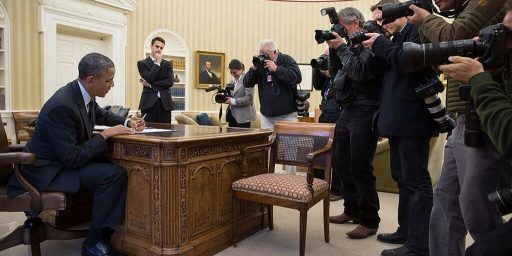Reuters Purges All 920 Adnan Hajj Photos from Database
Reuters has removed all 920 photos taken by Adnan Hajj from its archives:
Reuters withdrew all 920 photographs by a freelance Lebanese photographer from its database on Monday after an urgent review of his work showed he had altered two images from the conflict between Israel and the armed group Hizbollah.
Global Picture Editor Tom Szlukovenyi called the measure precautionary but said the fact that two of the images by photographer Adnan Hajj had been manipulated undermined trust in his entire body of work. “There is no graver breach of Reuters standards for our photographers than the deliberate manipulation of an image,” Szlukovenyi said in a statement. “Reuters has zero tolerance for any doctoring of pictures and constantly reminds its photographers, both staff and freelance, of this strict and unalterable policy.”
There have been several such photos from Hajj documented in the blogosphere, so this is probably best. Of course, it has the side benefit of making it more difficult for anyone outside Reuters to go back and investigate how many other Hajj forgeries have accompanied Reuters stories.
Regardless of how one feels about Reuter’s “standards” at this point, one has to give credit where credit is due: They didn’t do a Dan Rather on this one. Once the forgery was made known, they moved quickly to admit error and distance themselves from the incident. Considering that this broke on the blogs Friday night, that the first mea culpa was issued Saturday morning, the stringer was “fired” Sunday evening, and the entire database purged by Monday morning is blazingly fast even by the standards of the digital age.
UPDATE: AllahPundit notes, “The photos are still available on the wires, of course. They’ll just no longer be offered for sale by Reuters.” Interesting.






James, I continue to think that a lot more is being made of this story than is really warranted. Reuters undoubtedly is more likely to select a dramatic picture than a dull one. There’s an incentive for stringers to “spice up” their submissions. Reuters editors undoubtedly don’t have the time, skills, or inclination to do as much poring over stringers’ photos as bloggers do. They released the stringer. He’ll probably be back under another name in a week.
Whatever harm has already been done and can’t be undone. As you note, Reuters has acted promptly. What’s all the hoopla?
Dave,
There have been several events like this that can be rationally seen to have a tilt or bias in one direction. AP reporting ‘Boos’ from a GOP crowd heard Clinton had a heart attack when the audio didn’t record the boos, rather recorded support for the wish of a speedy recovery. Rather’s TNG fiasco. CNN’s ‘deliberate targeting journalist’ when they thought their words would not be generally known. There’s lots more.
Any one event would be passed off as a regrettable error. The trend is that the original errors tend to support the left’s view of the world. If the errors gored both sides ox in rough parity, we would tend to assign the mistakes to incompetence, not malice. But when we keep seeing mistake after mistake by influential news organizations and there doesn’t seem to be an effective effort to correct the problem, then each additional incident becomes another straw on the camels back. If you look at news paper and TV news circulation/viewing rates (especially in light of population trends), I think you are seeing the impact of all of those straws. For some it has already broken the camels back and getting their trust that the news will be reportedly fairly and unbiased is going to be difficult. Each new incident like this will continue to cut into their believability.
I would think that if Reuters really wanted to try and undue the harm, they would figure out what in their system allows them to use hundreds of photos from a source who did not seem to hesitate to fake the photos (whether that fakery was inspired by money, ideology, insanity or whatever) and announce how they are going to fix the problem at its source so it doesn’t happen again. Absent that, any picture or report from Reuters has to be taken with the grain of salt that they got fooled once and they may have been fooled again. They are now using a more senior editor to approve the photographs, but what does that say about all the other photo’s they get?
I just don’t see how you can excuse deliberate manipulation of a picture. Editing brightness/contrast/exposure or even cropping (although you could play the bias game with this, cropping doesn’t trouble me as much) is acceptable manipulation, but adding or taking away changes the story a picture is telling, and people should be able to expect their news to tell the truth.
“Any one event would be passed off as a regrettable error. The trend is that the original errors tend to support the left’s view of the world. ”
Like Judith Miller’s articles? Like the Aluminum tubes story? The Balloon trucks?
While I agree with yetanotherjohn wholeheartedly only because he’s right, I gotta shout out a TOUCHE! to the above quote. That’s funny!